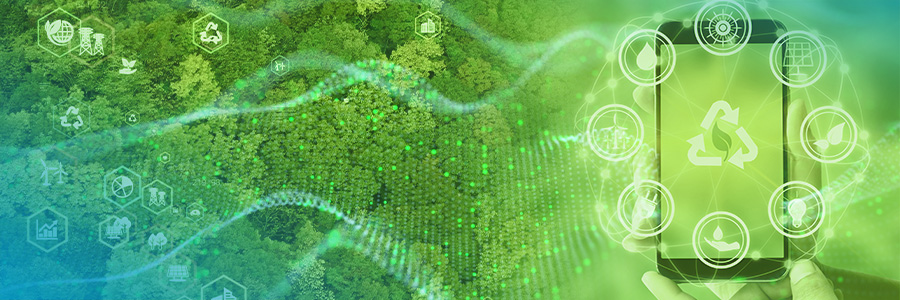
Many businesses around the globe want to do their part to reduce their carbon footprint. They recycle, reduce emissions and may even have employee incentives to help with these initiatives.
But there’s more organizations can do to help reduce their carbon footprint, and as an added bonus, reduce their budgets. Enter Green IT. The goal of Green IT is to reduce the negative impact IT operations have on the environment, like producing e-waste.
So, what is Green IT? What’s e-waste? And why should you care?
Let’s dive in.
What is Green IT?
To get technical, Green IT (green information technology) green computing, or Information and Communication Technology (ICT) sustainability, is the study and practice of environmentally sustainable computing or IT. In basic terms, Green IT encourages businesses to take a closer look at their IT department to evaluate how sustainable their IT strategies and practices are.
Green IT is part of a movement to raise awareness about the seriousness of climate change and the need to reevaluate the disposal of electronic materials that contribute to a circular and regenerative economy. The goals of Green IT are similar to other environmental objectives:
- Reduce the use of hazardous materials
- Maximize energy efficiency during the lifecycle of a mobile device
- Understanding the recyclability or biodegradability of products and the waste they create
Practicing Green IT is important for organizations big and small who use corporate devices from smartphones and tablets to computers and industrial printers. With some attention paid to sustainability, IT departments can add new and evolving goals to their sustainability practices. An important part of IT should be to develop more eco-friendly ways to carry out day-to-day activities. Having a strategic IT department also involves a greener IT department.
Having Green IT shows your organization’s ability to understand the importance of sustainability. Some of the advantages of Green IT are:
- Reduced and more intelligent energy consumption
- Reduced cost of equipment
- Modernization of equipment and more extended maintenance periods
- Increase in performance and productivity
- Valuing brand, image and reputation
Companies can benefit by taking small steps to adapt and adjust their sustainability practices. Now is the time for the IT sector (and its workers) to develop a positive attitude toward addressing these environmental concerns and adopt forward-looking, green-friendly policies and practices.
Want to learn more about how your it department can go green?
Visit soti.net/sustainabilityWhat is E-Waste?
To get technical, electronic waste (e-waste) describes discarded electrical or electronic devices. When a device is tossed, whether it’s done properly or improperly, that’s e-waste. Electronic waste can include dangerous chemicals like lead, cadmium, beryllium, mercury and brominated flame retardants (BFRs). When we dispose of gadgets and devices improperly, these hazardous materials have a high risk of polluting the air, contaminating soil and getting into our water sources.
From defective electronics to old smartphones, the total amount of e-waste generated around the world in 2021 has been estimated to a record 57.4 million tons. That is more than the weight of the heaviest artificial object on Earth, the Great Wall of China.
One way to tackle the challenge of e-waste is to recycle old and unused devices. Putting old devices in the trash or storing them in a box won’t help your business or the environment. The general public estimate that about half of e-waste is recycled, but the reality is much bleaker as globally, just a little over 17% of electronics were known to be properly treated and recycled in 2019.
So how can you recycle e-waste properly? There’s more than one way:
- Use a certified e-waste recycler
- Explore retail locations to recycle e-waste
- Donate electronics to be used by others
But before you do any of the above, make sure you:
- Transfer data to a computer, hard drive, USB or the Cloud
- Sign out of all accounts
- Wipe the device
Ideally, the first step will be to only purchase or replace electronics and their accessories, like batteries, when necessary. But how can you know if a battery needs to be replaced?
- The device runs out of power much faster than when it was new
- Device won’t charge fully
- As soon as the device is disconnected from the charger, the battery drops 10 to 20%
- The battery is bulging. If this happens to your battery, it’s not dying, it’s dead
Don’t get pulled into the hype of new technology if it’s not needed for your business or for workers to perform their jobs. And, when a device is no longer needed, take the time to find a responsible e-waste recycler.
IT departments can practice Green IT and be a part of the solution. Every organization, big or small can help stop e-waste from making its way into landfills, and even make their budgets a little greener.
Why Should You Care?
Many businesses think practicing Green IT can mean high cost, but reducing e-waste can save tons of money for your bottom line. Take batteries for example, they can be very costly to purchase, and many organizations simply replace all batteries at once because they lack visibility into the lifespan of a battery on any given device. Only replace accessories, like batteries, when it’s needed for the device. This will save money on unnecessary purchases and keep e-waste, like perfectly good batteries, out of landfills.
Switching or upgrading devices unnecessarily is costly. Take the number of devices, multiply by the cost per device and that can be very expensive. But what many businesses fail to account for is downtime to switch from old to new devices, as well as time spent collecting, data dumping and wiping devices. Another consideration is training for workers to understand and learn how to efficiently use the new device they’ve been given. This impacts the budget and valuable time workers could be spending performing their jobs.
The average lifespan of an enterprise smartphone is currently 2.55 years, which is projected to decline to 2.44 years by 2024. That’s not a long time for a corporate device to last and can be costly to any organization. But there’s really no need to replace devices that are only two to three or even five years old because many still function perfectly. If employees don’t need the best camera or the latest technology, there’s no need to upgrade to the newest model. Instead, organizations need to consider keeping devices a bit longer and manage them with a diagnostic intelligence solution to get the most out of their lifespan.
Another benefit to practicing Green IT? Security. While old devices are probably powered off, any devices that are left on, connected to your network or logged into corporate accounts could pose a security risk. For example, if the device was previously compromised with malware, it could have an open vulnerability if left on.
Every time a device is replaced, it’s the IT departments’ responsibility to be sure the old one gets recycled properly. Green IT is good business for IT departments, for companies, and of course, for the planet. Sustainability initiatives such as Green IT don’t have to be cumbersome. There are practical ways to do good for the environment and for your business.
Check out soti.net/sustainability to learn more about practical sustainability for enterprise mobility.



